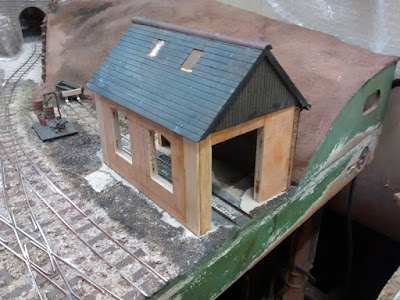Develop yard road surfaces
Finish vertical drill
Develop mine siding area
Following the previous weeks road plastering, Geoff had filled the areas around the timber infill with more Smooth-It. A light scrape and sand finished off the interfaces. The area between the main siding and the head shunt were now treated with PVA and more plaster. This area is intended to be a coaling stage/collection point, and the surface will be treated to represent compacted ash.
A coating of 'Yard Filth' was applied at one end, as a trial. Grubby brown in colour, the paint also has some texture material in it that created quite a nice effect.
Geoff went on the cut out and glue down section of paving setts for the main yard area.
Gulleys and manholes will be fitted in due course, together with the other paving panels which we hope to pick up at the Epsom & Ewell show the following weekend.
Laurence fitted a dividing head plate he'd made for the vertical drill. He also cleaned up the electric motor and pulley assembly that sits over and drives the drill.
 |
| Just the old platform to be removed |
 |
| New timber sleeper platform edging |
 |
| The van being tested in place. The platform may require amendment |

























